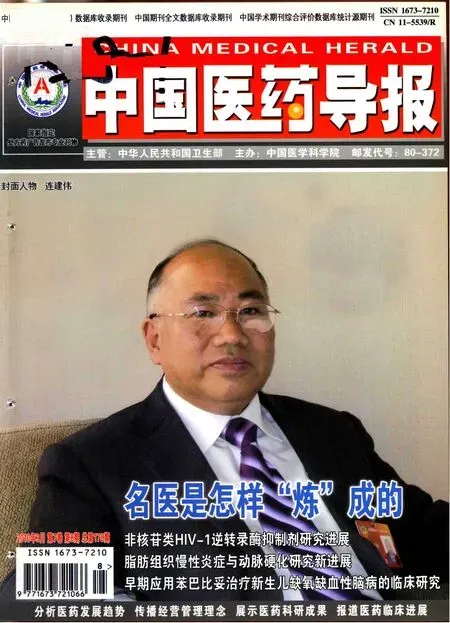脂肪組織慢性炎癥與動脈硬化研究新進展
李江波,呼和 朝魯,鄭凱駿,李迎霄,厚地 香,寺師 睦美,網谷 東方,
鮫島 真理恵,迫口 武夫,中山 尚子,蔡明倫,牛飼 美晴,淺川 明弘,乾 明夫
(日本鹿児島大學醫歯學総合研究科心身內科學,日本鹿児島 890-8520)
近年來研究表明,肥胖是代謝綜合征、糖尿病、高血壓、高血脂、動脈硬化性疾病的高風險因素。肥胖常伴隨炎癥性免疫蛋白因子的增加以及具有抗感染、改善胰島素抵抗作用的脂聯素(adiponectin)降低,導致胰島素抵抗和肥胖脂肪組織的巨噬細胞浸潤,巨噬細胞與脂肪組織相互作用,導致脂肪功能障礙。代謝綜合征的發生、發展與慢性炎癥機制密切相關[1-2]。這一機制的發現或許使許多過去原因不明的血管性、代謝性、免疫性疾病可以重新從肥胖脂肪的慢性炎癥這個角度出發,重新認識和研究,可能發現新的機制和治療方法。實際上,已有報道用抗血管內皮生長因子 (vascular endothelial growth factor,VEGF)抗體和兔抗人細胞間黏附分子-2(rabbit antihuman intercellular adhesion molecule,ICAM-2)抗體可以抑制脂肪組織炎癥,改善全身代謝情況[2-4]及抗感染。本文對近年來肥胖、代謝綜合征、脂肪肝和動脈硬化性疾病的共同病理基礎——慢性炎癥的研究新進展作一綜述。
1 肥胖及代謝疾病脂肪組織的慢性炎癥機制
由于經常攝入高脂肪、高熱量食物,過多的脂肪酸及葡萄糖流入脂肪細胞及肥胖脂肪血流不暢等原因誘導了氧化應激和小胞體應激反應的刺激,結果使脂肪細胞內激活了氨基末端激酶(c-Jun NH2terminal kinase,JNK)和復合體磷酸化(I-κβ kinase,IKKβ)通路,這是兩條炎癥通路,從肥胖脂肪組織細胞中分泌單核細胞趨化蛋白-1(monocyte chemotactic protein 1,MCP-1)、巨噬細胞炎癥蛋白-1α(macrophage inflammatory protein1 alpha,MIP-1α)、促黑激素釋放抑制因子(melanocyte stimulating hormone inhibiting factor,MIF)。 血中單核細胞向脂肪組織誘導,分化為成熟的巨噬細胞。脂肪組織被激活的巨噬細胞進一步釋放腫瘤壞死因子(tumor necrosis factor α,TNF-α)、白細胞介素-1(interleukin 1,IL-1)和白細胞介素-6(interleukin 6,IL-6)等炎癥性免疫蛋白因子和MCP-1等炎癥蛋白,促進單核細胞和炎癥細胞向脂肪組織浸潤,即肥胖的脂肪組織炎癥可以理解為脂肪組織過度蓄積能量物質所誘導的炎癥過程[5-6]。
隨著影像技術的發展,現在已能在活體動物體內觀察脂肪發生炎癥的過程。在肥胖的進展中,脂肪組織中發現有多數小型脂肪細胞,其周圍有凝集素(lectin)陽性的小細胞存在,這些小的脂肪細胞群是正在分化成長中的細胞,它的所在是脂肪新生的場所,被稱為脂肪的血管新生細胞群(adipo-/angiogenic cell clusters),周圍有血管。它們用抗VEGF抗體抑制新生血管,結果血管及小脂肪細胞均消失,證明脂肪新生離不開血管的新生,脂肪血管生成細胞群可能是肥胖脂肪組織新生小脂肪細胞的共同機制[7]。同時還可以觀察到另一類與脂肪的血管新生細胞群完全不同類型的巨噬細胞群,這些細胞凝集素反應陰性,與血管無關,它們呈王冠形聚集在脂肪細胞的周圍[8],吞噬死亡的脂肪細胞,隨著肥胖的進展,脂肪組織間質的巨噬細胞數不斷增加。db/db小鼠脂肪組織細胞增大時,脂肪的血管新生細胞團以及脂肪細胞數增加,以后脂肪的血管生成細胞團的數量減少。脂肪細胞直徑增大,使脂肪體積增大。巨噬細胞不僅處理死亡的脂肪細胞,還通過釋放TNF-α等炎癥性免疫蛋白因子使脂肪細胞功能發生障礙,TNF-α刺激脂肪細胞分解,從脂肪細胞釋放出來的游離脂肪酸可以活化巨噬細胞,脂肪細胞與巨噬細胞相互作用引起炎癥[1,9]。在肥胖脂肪炎癥過程中,脂肪細胞的增生和肥大、巨噬細胞的浸潤、巨噬細胞與脂肪組織的相互作用是重要環節,而炎癥性免疫蛋白因子是重要媒介。
非肥胖的脂肪組織的巨噬細胞多為具有抗感染性的M2型,通過產生精氨酸酶抑制炎癥生成[10]。M2型巨噬細胞的功能與具有脂肪細胞分解和蓄積調節功能的過氧化酶體增殖物激活受體 γ(peroxisome proliferator activated receptor γ,PPARγ)密切相關,PPARγ可能起到維持M2型巨噬細胞的極性和胰島素敏感性的作用,PPARγ缺損的小鼠,給予高脂肪飲食更容易肥胖,導致脂聯素降低而胰島素抵抗性增高[11],導致全身炎癥的易感狀態。用n-3多價不飽和脂肪酸(n-3 polyunsaturated fatty acids,n-3PUFAs)的二十碳五烯酸(EPA)可以改善脂肪組織分泌調節功能障礙[12]。肥胖時脂肪組織抗感染性M2型巨噬細胞減少,而炎癥性M1型巨噬細胞及炎癥性免疫蛋白因子增多,促進炎癥反應[10]。
肝臟、骨骼肌、脂肪組織都是胰島素感受器官,擔當糖和脂肪代謝的重要功能,同時還是免疫器官,處理各種抗原和淋巴細胞。高脂肪飲食誘導肥胖小鼠的肝臟IKKβ和核因子-κB(NF-κB)活性上升,IL-1、IL-6、TNF-α 等炎癥性免疫蛋白因子表達增加[13],而IKKβ缺損的小鼠胰島素抵抗也被抑制,炎癥性免疫蛋白因子 IL-1α、IL-1、IL-6 減少[14]。肥胖致肝臟病態是由于營養過剩導致肝細胞中性脂肪蓄積,脂肪組織的肥大激活了肝臟炎癥性通路,同時誘導了胰島素抵抗,導致肝臟炎癥和脂肪肝。
2 肥胖脂肪炎癥與胰島素抵抗
胰島素抵抗是糖尿病的重要病理機制。由于過剩的葡萄糖和脂肪酸流入脂肪和肝細胞,使細胞內氧化應激和小胞體應激增大,激活炎癥性信號的兩條重要通路(IKKβ和JNK通路)[15-16],使炎癥性免疫蛋白因子TNF-α、IL-6和單核細胞趨化蛋白MCP-1增加,一方面,TNF-α直接抑制胰島素信號;另一方面,TNF-α通過TNF受體,游離脂肪酸通過TLR(toll-like receptor,TLR)受體激活炎癥通路,導致炎癥和胰島素抵抗[6,17-19]。TNF-α促進中性脂肪分解,是引起高游離酸血癥、胰島素抵抗和脂肪肝脂質異常的重要原因,阻斷小鼠的TNF-α信號則可以改善胰島素抵抗[3-4]。MCP-1增高的小鼠,脂肪組織巨噬細胞浸潤和胰島素抵抗增高[5-6],而MCP-1和其主要受體CCR2缺損的小鼠,即使喂高脂肪飲食,其脂肪組織巨噬細胞浸潤也被抑制,同時胰島素感受性和脂肪肝也得到改善,使用CCR2拮抗劑也可改善高脂肪飲食喂養小鼠的胰島素抵抗[20]。
3 炎癥與動脈硬化
近年來病理組織學及分子細胞生物學研究證明,氧化應激、氧化的低密度脂蛋白(low density lipoprotein,LDL)、炎癥反應、免疫應答等是動脈硬化進展的重要因素[21-22]。動脈硬化與氧化LDL以及氧化應激、C反應蛋白(C reactive protein,CRP)的炎癥反應相關。氧化LDL不僅參與膽固醇在血管壁的沉積,還誘導基質金屬蛋白酶(matrix metalloproteinase,MMPs)的表達,促進炎癥反應,炎癥又進一步誘導氧化應激,形成惡性循環。CRP可誘導炎癥蛋白和黏著分子的表達、誘導氧化LDL 受體(lectin-like oxidized LDL receptor 1)的表達、促進炎癥反應和動脈硬化[23-25],而具有抗感染作用的司他汀(Statin)能降低CRP、脂質及心肌梗死發病率[26-28]。最近有報道用新開發的3.0 Tesla MRI與magnetic nanoparticle技術合用檢查和評價動脈硬化病變的巨噬細胞的活性,發現巨噬細胞產生MMPs,加重動脈硬化[29]。
氧化LDL和炎癥反應主要在血管壁上發生,其血管內皮細胞、血管細胞黏附因子(VCAM-1)、MCP-1過度表達,誘導血液中單核細胞向血管壁浸潤,在動脈壁內單核細胞分化成巨噬細胞,進一步在氧化和炎癥性免疫蛋白因子影響下促進巨噬細胞增殖[7,30]。動脈硬化病灶內巨噬細胞浸潤部位的血管新生因子(VEGF-A)與淋巴新生因子(VEGF-C)表達增加[31-32],其血管新生和巨噬細胞浸潤與動脈硬化呈正相關[33]。
動脈硬化的成因相當復雜,但近年來許多研究幾乎都傾向于炎癥性改變是動脈硬化性疾病血管改變的特征之一,基于這種新的認識,也許可以期待今后開發出更多治療威脅人類健康的心腦血管疾病等疑難病癥的新藥物和新療法。
[1]Suganami T,Nishida J,Ogawa Y.A paracrine loop between adipocytes and macrophages aggravates inflammatory changes:role of free fatty acids and tumor necrosis factor alpha[J].Arterioscler Thromb Vasc Biol,2005,25(10):2062-2068.
[2]Nishimura S,Manabe I,Nagasaki M,et al.In vivo imaging in mice reveals local cell dynamics and inflammation in obese adipose tissue[J].J Clin Invest,2008,118(2):710-721.
[3]Larsen CM,Faulenbach M,Vaag A,et al.Interleukin-1-receptor antagonist in type 2 diabetes mellitus[J].N Engl J Med,2007,356(15):1517-1526.
[4]Fleischman A,Shoelson SE,Bernier R,et al.Salsalate improves glycemia and inflammatory parameters in obese young adults[J].Diabetes Care,2008,31(2):289-294.
[5]Kanda H,Tateya S,Tamori Y,et al.MCP-1 contributes to macrophage infiltration into adipose tissue,insulin resistance,and hepatic steatosis in obesity[J].J Clin Invest,2006,116(6):1494-1505.
[6]Kamei N,Tobe K,Suzuki R,et al.Overexpression of monocyte chemoattractant protein-1 in adipose tissues causes macrophage recruitment and insulin resistance[J].J Biol Chem,2006,281(36):26602-26614.
[7]Aikawa M,Rabkin E,Sugiyama S,et al.An HMG-CoA reductase inhibitor,cerivastatin,suppresses growth of macrophages expressing matrix metalloproteinases and tissue factor invivo and in vitro[J].Circulation,2001,103(2):276-283.
[8]Cinti S,Mitchell G,Barbatelli G,et al.Adipocyte death defines macrophage localization and function in adipose tissue of obese mice and humans[J].J Lipid Res,2005,46(11):2347-2355.
[9]Suganami T,Tanimoto-Koyama K,Nishida J,et al.Role of the Toll-like receptor 4/NF-kappa B pathway in saturated fatty acid-induced inflammatory changes in the interaction between adipocytes and macrophages[J].Arterioscler Thromb Vasc Biol,2007,27(1):84-91.
[10]Lumeng CN,Bodzin JL,Saltiel AR.Obesity induces a phenotypic switch in adipose tissue macrophage polarization[J].J Clin Invest,2007,117(1):175-184.
[11]Odegaard JI,Ricardo-Gonzalez RR,Goforth MH,et al.Macrophagespecific PPARgamma controls alternative activation and improves insulin resistance[J].Nature,2007,447(7148):1116-1120.
[12]Itoh M,Suganami T,Satoh N,et al.Increased adiponectin secretion by highly purified eicosapentaenoic acid in rodent models of obesity and human obese subjects[J].Arterioscler Thromb Vasc Biol,2007,27(9):1918-1925.
[13]Cai D,Yuan M,Frantz DF,et al.Local and systemic insulin resistance resulting from hepatic activation of IKK-beta and NF-kappaB[J].Nat Med,2005,11(2):183-190.
[14]Arkan MC,Hevener AL,Greten FR,et al.IKK-beta links inflammation to obesity-induced insulin resistance[J].Nat Med,2005,11(2):191-198.
[15]Furukawa S,Fujita T,Shimabukuro M,et al.Increased oxidative stress in obesity and its impact on metabolic syndrome[J].J Clin Invest,2004,114(12):1752-1761.
[16]Hung JH,Su IJ,Lei HY,et al.Endoplasmic reticulum stress stimulates the expression of cyclooxygenase-2 through activation of NF-kappaB and pp38 mitogen-activated protein kinase[J].J Biol Chem,2004,279(45):46384-46392.
[17]Tilg H,Moschen AR.Inflammatory mechanisms in the regulation of insulin resistance[J].Mol Med,2008,14(3):222-231.
[18]Wellen KE,Hotamisligil GS.Inflammation,stress,and diabetes[J].J Clin Invest,2005,115(5):1111-1119.
[19]Weisberg SP,McCann D,Desai M,et al.Obesity is associated with macrophage accumulation in adipose tissue[J].J Clin Invest,2003,112(12):1796-1808.
[20]Weisberg SP,Hunter D,Huber R,et al.CCR2 modulates inflammatory and metabolic effects of high-fat feeding[J].J Clin Invest,2006,116(1):115-124.
[21]Libby P.Molecular bases of the acute coronary syndromes[J].Circulation,1995,97(11):2844-2850.
[22]Hansson GK.Inflammation,atherosclerosis,and coronary artery disease[J].N Engl J Med,2005,354(16):1685-1695.
[23]Holvoet P,Vanhaecke J,Janssens S,et al.Oxidized LDL and malondialdehyde-modified LDL in patients with acute coronary syndromes and stable coronary artery disease[J].Circulation,1998,100(15):1487-1494.
[24]Toshima S,Hasegawa A,Kurabayashi M,et al.Circulating oxidized low density lipoprotein levels.A biochemical risk marker for coronary heart disease[J].Arterioscler Thromb Vasc Biol,2000,20(10):2243-2247.
[25]Ehara S,Ueda M,Naruko T,et al.Elevated levels of oxidized low density lipoprotein show a positive relationship with the severity of acute coronary syndromes[J].Circulation,2001,103(15):1955-1960.
[26]Aikawa M,Libby P.The vulnerable atherosclerotic plaque:pathogenesis and therapeutic approach[J].Cardiovasc Pathol,2004,13(3):125-138.
[27]Libby P,Aikawa M.Stabilization of atherosclerotic plaques:new mechanisms and clinical targets[J].Nat Med,2002,8(11):1257-1262.
[28]Aikawa M.Effects of statin therapy on vascular dysfunction[J].Coron Artery Dis,2004,15(5):227-233.
[29]Deguchi JO,Aikawa M,Tung CH,et al.Inflammation in atherosclerosis:visualizing matrix metalloproteinase action in macrophages in vivo[J].Circulation,2006,108(1):55-62.
[30]Sakai M,Kobori S,Miyazaki A,et al.Macrophage proliferation in atherosclerosis[J].Curr Opin Lipidol,2000,11(5):503-509.
[31]Chen YX,Nakashima Y,Tanaka K,et al.Immunohistochemical expression of vascular endothelial growth factor/vascular permeability factor inatheroscleroticintimasofhumancoronaryarteries[J].ArteriosclerThromb Vasc Biol,1999,19(1):131-139.
[32]Nakano T,Nakashima Y,Yonemitsu Y,et al.Angiogenesis and lymphangiogenesis and expression of lymphangiogenic factors in the atherosclerotic intima of human coronary arteries[J].Hum Pathol,2005,36(4):330-340.
[33]Kumamoto M,Nakashima Y,Sueishi K.Intimal neovascularization in human coronary atherosclerosis:its origin and pathophysiological significance[J].Hum Pathol,1995,26(4):450-456.

